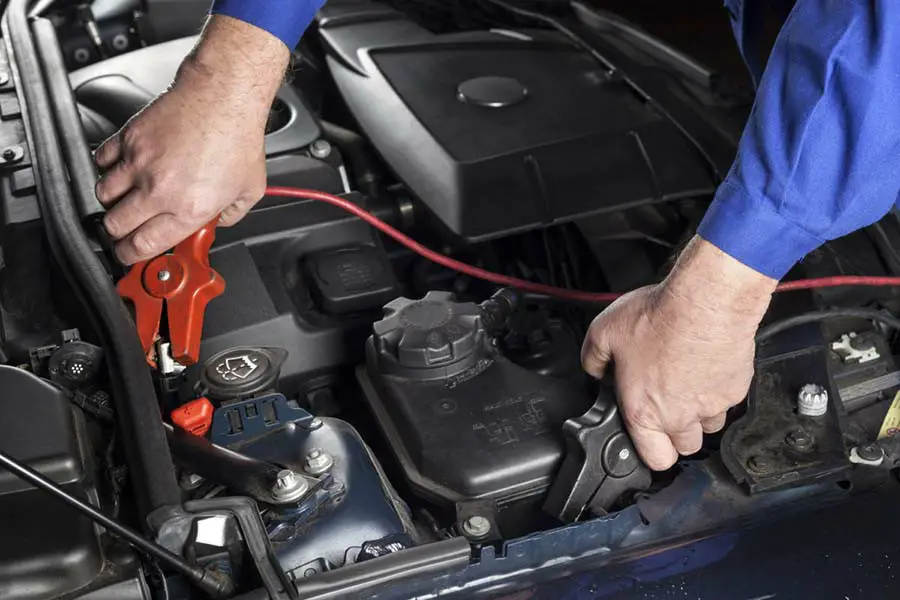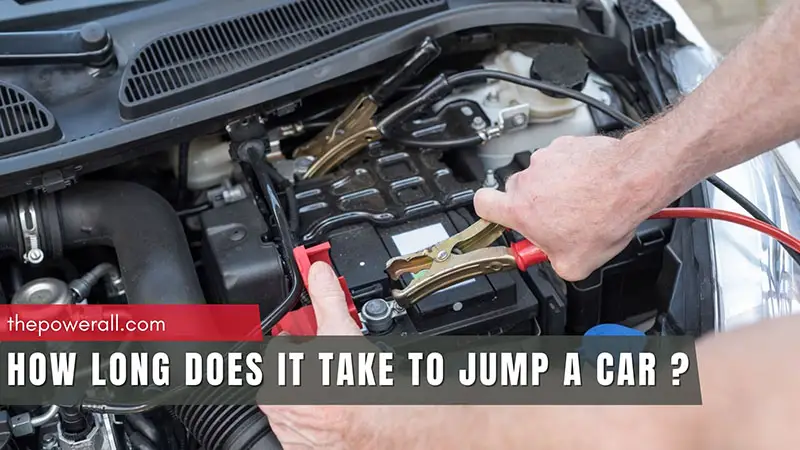If you have ever found yourself in a situation where your vehicle needs a jump start, you may wonder how long it will take to jump start the car. Luckily, the answer is in this post. Keep on reading to learn more details about the matter!
What Makes Your Vehicle Require A Jump Start?
A jump start is a common way to get your car back on track when it suddenly fails. There are several reasons why it may require this procedure, and understanding the causes can help you prevent the need for one.
Weak Or Dead Battery

The battery provides the initial power to turn the engine over and start the car. So when it is not functioning correctly, the automobile may not start at all.
There are several reasons why a battery may become weak or die, such as leaving lights or other electronics on when the car is turned off, an old or weakened battery, and so on.
Faulty Starter
Let’s say you hear a grinding or slow cranking sound when you turn the key. This can be a sign of a bad starter motor, which can call for a jump start.
Clogged Fuel Lines
The purpose of the fuel line is to deliver fuel from the fuel tank to the engine. Over time, the filtered particles might accumulate and block the gasoline filter. When this happens, it can stop gasoline from reaching the engine, preventing your car from starting.
Malfunction Spark Plugs
If the spark plugs are not firing correctly or are misfiring, it can cause the engine to run poorly or not at all. This can result in a higher load on the battery, causing it to drain faster and reducing its overall lifespan.
Extreme Temperature
In cold weather, the battery’s chemical reactions slow down, reducing its ability to deliver power to the engine. This can make the starter motor struggle and the battery to lose its charge more quickly.
How Long To Jump A Dead Battery

Generally, a jump start can take anywhere from 5 minutes to around 30 minutes. Still, the actual time it takes to jump-start an automobile can vary depending on several factors.
For instance, suppose the battery is only slightly discharged; the process may take only a few minutes before your car can operate as normal. On the contrary, the time will be longer when your battery is completely dead or severely discharged.
The type of vehicle can also affect the jump-starting time. As larger vehicles come with bigger batteries, it will surely take longer to perform the procedure than smaller ones with smaller batteries.
Besides the above elements, your choice of methods may make a big time difference. Using jumper cables to connect and charge batteries with another vehicle requires more time and effort, as it involves positioning the cars and connecting the cables correctly. Meanwhile, you can fasten the charging process with a portable jump starter box.
How To Jump A Car
There are several ways to perform this task. We will walk you through the most common methods, both with and without a donor vehicle.
Without A Donor Car
Bump-Starting
Step 1: Turn on your ignition.
Step 2: Engage the second gear on the gearbox.
Step 3: Depress the clutch pedal.
Step 4: Have another person start pushing the car from the outside.
Step 5: When the vehicle has gained momentum, usually about five miles per hour, slowly release the clutch while gradually depressing the gas pedal.
Note: This technique requires another person’s help. Once you finish the last step, your car should be able to start. If not, try to repeat the process a couple more times. In the worst-case scenario, even after several tries, you are still unable to achieve your goal, knowing that your issue is not a dead battery.
Using Rope
Step 1: Engage the third gear on the gearbox.
Step 2: Jack up one of your front wheels.
Step 3: Encircle the lifted wheel with the rope.
Step 4: Try to pull the rope as firmly as possible; the vehicle should then begin.
Note: This repair only applies to gasoline vehicles with front-wheel drive and a manual transmission. It will, regrettably, not work if your automobile has an automatic transmission, four wheels, or is powered by diesel.
With A Donor Car
Step 1: Get yourself an engine source.
This process requires another car, whether it’s your own or someone’s close by. Place the two automobiles close enough to one another for the jumper cables to pass between the batteries. Still, keep them from touching, ideally, about 8 inches apart. Also, make sure the cars’ ignition and lights are off.
Step 2: Set up the jumper cables.
Connect one end of the red jumper cable to the dead battery’s positive terminal. Then, attach the other end to the positive terminal of the healthy battery.
Next, connect one end of the black jumper cable to the charged battery’s negative terminal. Meanwhile, the other end attaches to an unpainted metal surface on the engine block or frame of the dead car. Notice not to connect the black cable to the negative terminal of the defective battery.
Step 3: Start your engine.
Start the car with functional batteries. Run it for two minutes while putting a little pressure on the gas pedal. Try restarting the dead car battery’s engine at least four times before quitting.
Examine the cables and terminals connection if the dead battery-powered vehicle won’t retain a click or start. At this point, press the gas slightly to extend the time to even ten minutes instead of two.
Step 4: Disconnect the cars.
Turn off the engines of both cars. Disconnect the jumper cables in the reverse order you connected them, starting with the black cable and then the red one.
Step 5: Restart and let the engine run.
Let the engine of the jump-started car run for at least 20-30 minutes to allow the battery to build up a charge and stabilize its voltage. Do not turn off the engine or let it idle during this time, or the battery may not have enough charge to start the engine again.
However, in reality, the waiting period may vary depending on the battery’s condition and the type of jump starter used.
Note: Suppose this method doesn’t work; this means there’s a bigger issue requiring expert assistance. In this case, it is best to call roadside assistance and let the professional handle the situation.
Frequently Asked Questions
When Should You Not Jump Start A Car?
You should not jump-start a car if the battery is frozen, as it may result in an explosion. Also, jump-starting the automobile is not a good idea when it has exposed wires or terminals, a broken alternator, ECM issues, or has been sitting unused for a long time.
Can Jump Starting Harm My Car?
Jump-starting your car does not generally do any harm to your vehicle when done correctly. Otherwise, a power surge may occur, leaving you with many problems, such as damaged engine control units, faulty alternators, etc.
Thus, if you’re not confident in your skills to successfully deliver the task, tow the car to a reliable repair shop and let the mechanic handle the rest.
Can I Jump Start A Car With A Bad Alternator?
Yes, you can jumpstart a car that has a defective alternator, given that the car battery bears sufficient charge to run the car. That said, we highly recommend you change the alternator as soon as you can.
Will My Battery Automatically Recharge After Being Jumped?
No. Simply explained, neither a healthy auto battery nor a dead one can charge themselves. To be set, it always needs an outside power source, whether another vehicle or a jump box.
How Long Should I Wait To Start The Car After Jumping?
Immediately. Don’t let the car sit for any moment after jump-starting. The more time you delay, the lower chance the battery can fully recharge.
The Bottom Line
How long do you wait to jumpstart a car? As you can see, the time it takes to jump an automobile can vary depending on several factors. Still, with proper safety precautions and the right tools, you can successfully perform the task and get back on the road in a matter of minutes.
You might also like:









0 Comments